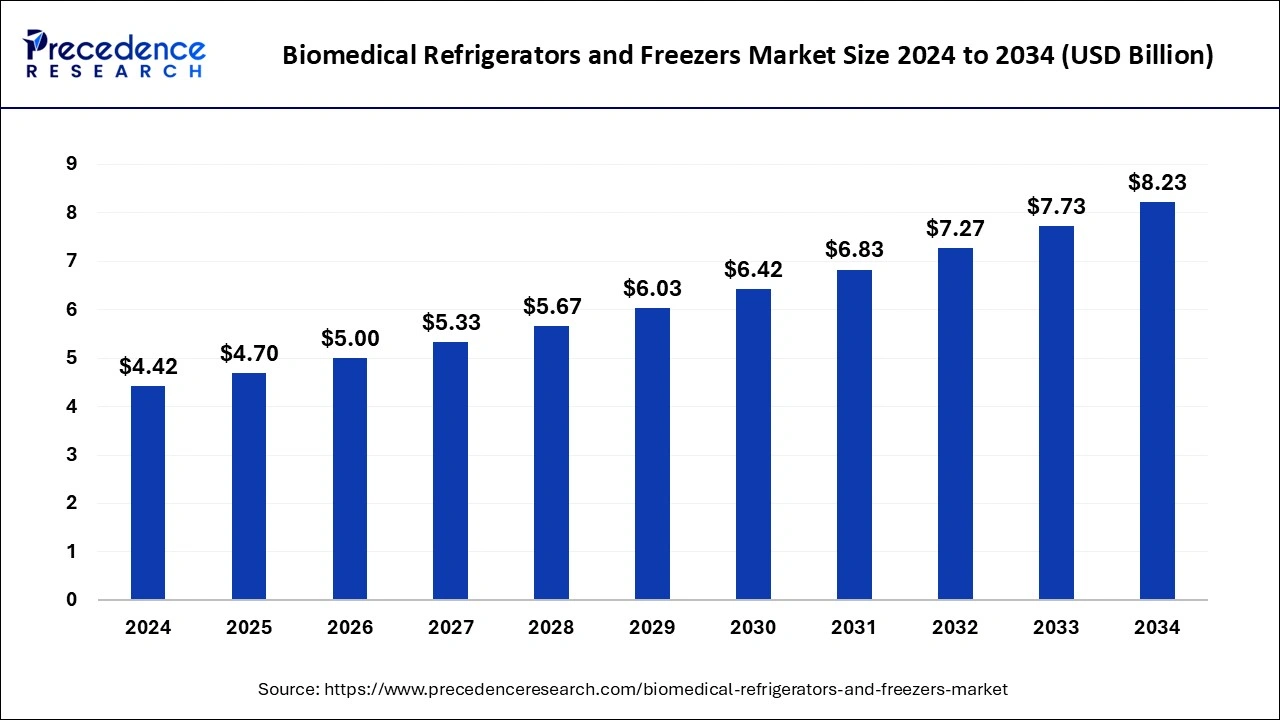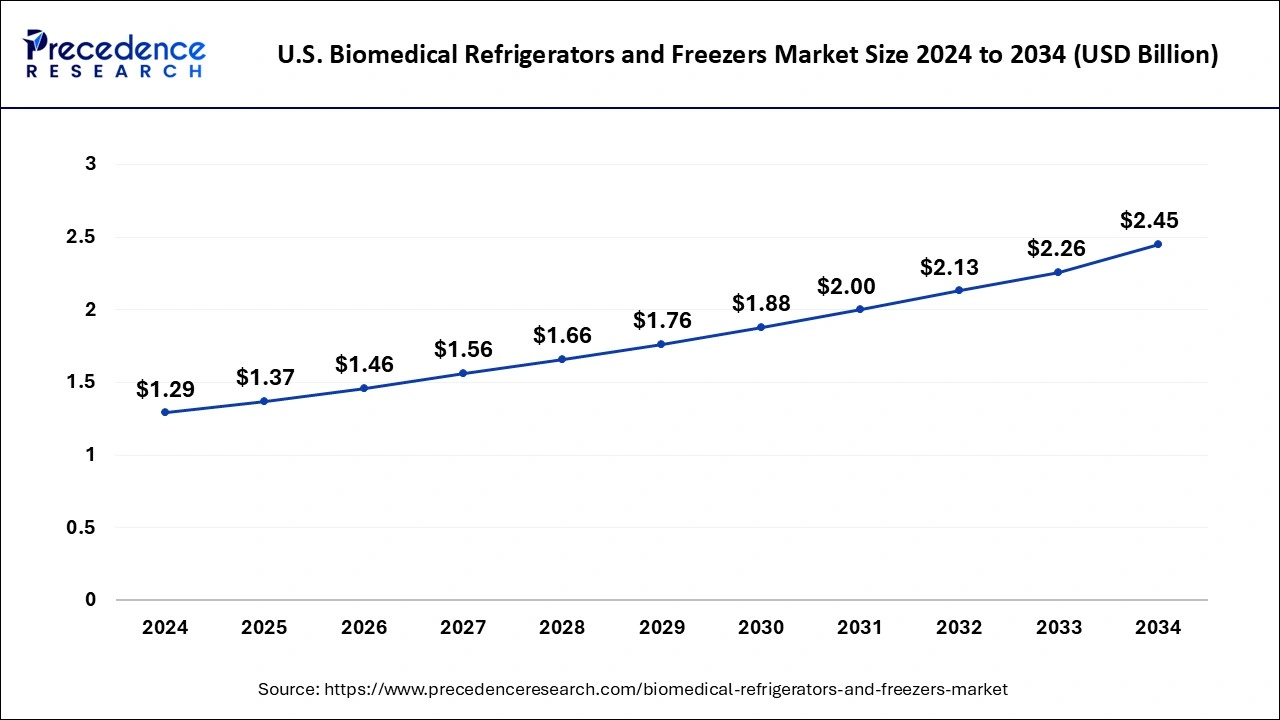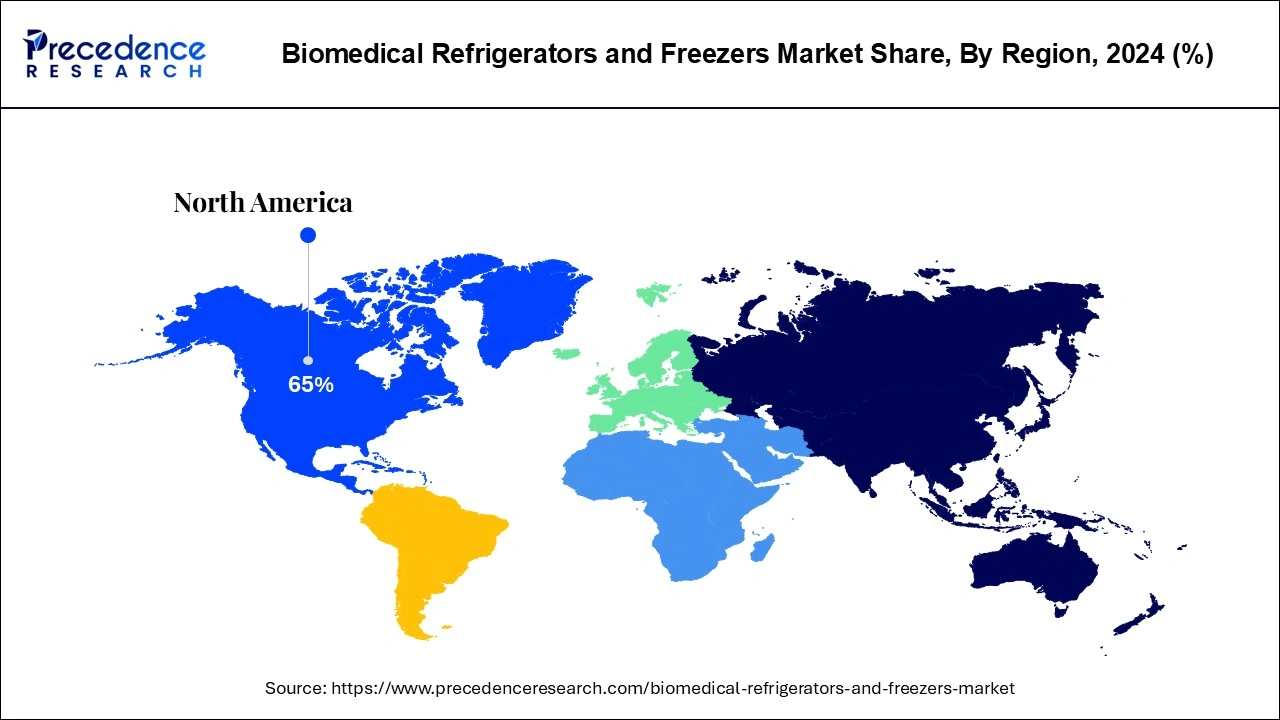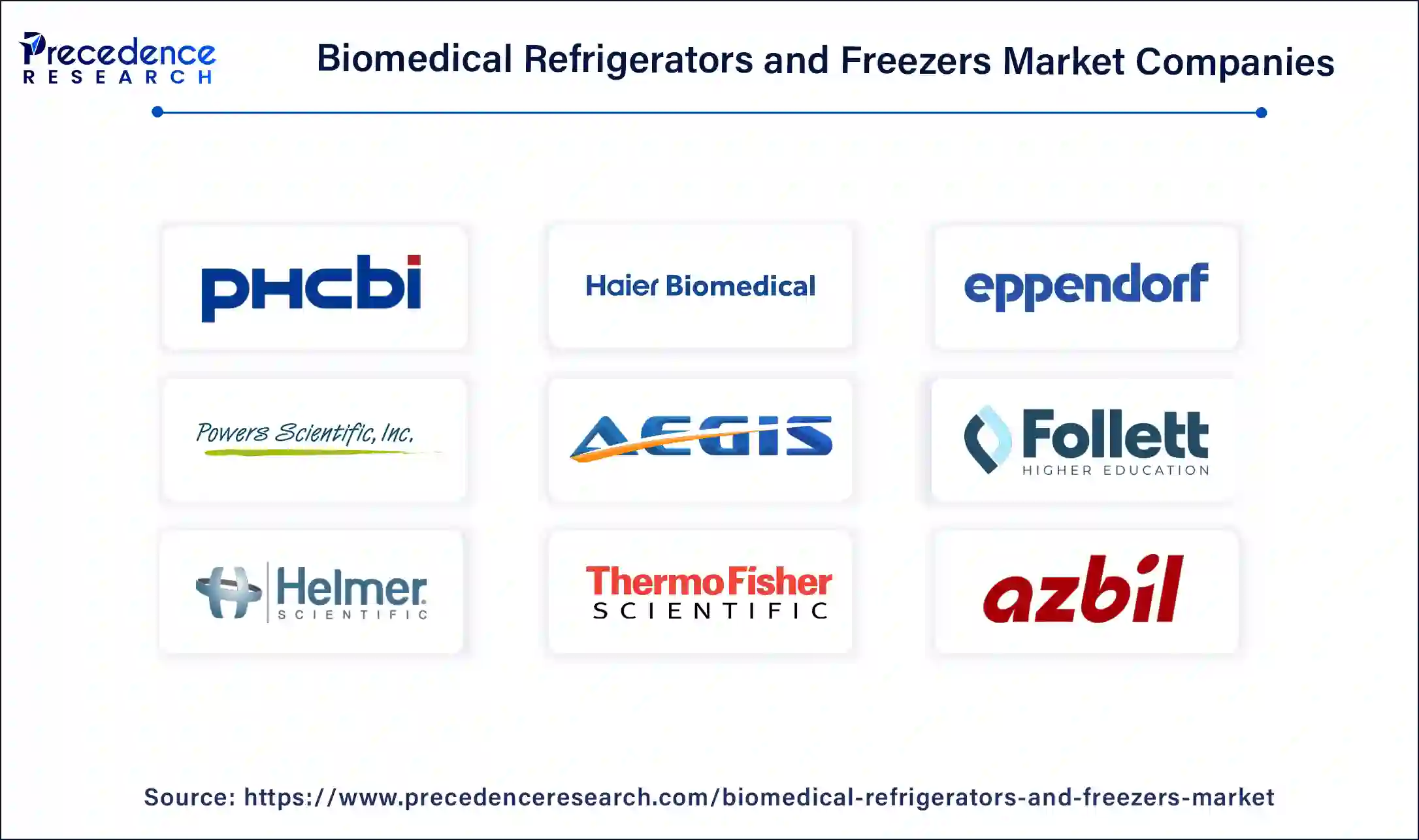The global biomedical refrigerators and freezers market size is calculated at USD 4.70 billion in 2025 and is forecasted to reach around USD 8.23 billion by 2034, accelerating at a CAGR of 6.41% from 2025 to 2034. The North America market size surpassed USD 2.87 billion in 2024 and is expanding at a CAGR of 6.50% during the forecast period. The market sizing and forecasts are revenue-based (USD Million/Billion), with 2024 as the base year.
The global biomedical refrigerators and freezers market size accounted for USD 4.42 billion in 2024 and is expected to exceed around USD 8.23 billion by 2034, growing at a CAGR of 6.41% from 2025 to 2034. The biomedical refrigerators and freezers market is expected to grow due to the increase in the adoption of biopharmaceuticals, the growth of healthcare industries, and the introduction of new technologies.

The incorporation of the Internet of Things and AI-driven monitoring solutions potentially improves efficiency and device management, in addition to green technologies that improve the energy efficiency of cooling systems. The use of Artificial Intelligence and automation technology is transforming the biomedical refrigerators and freezers market by improving functionality and information tracking systems. With the use of AI in monitoring, laboratories will be able to track the status of the refrigeration units and perform predictive maintenance to ensure that the samples do not spoil. Automation tools increase workflow by allowing remote control and monitoring of refrigerators, ensuring consistent temperature maintenance and compliance with safety regulations.
The U.S. biomedical refrigerators and freezers market size was exhibited at USD 1.29 billion in 2024 and is projected to be worth around USD 2.45 billion by 2034, growing at a CAGR of 6.62% from 2025 to 2034.

North America accounted for the largest biomedical refrigerators and freezers market share in 2024. North America, especially the U.S., has an established healthcare infrastructure consisting of improved healthcare facilities, research centers, and many related industries, mainly in the field of pharmaceuticals and biotechnology. This infrastructure creates the need for biomedical refrigerators to preserve biological products, vaccines, and drugs. An increased number of research and developments in the life sciences, pharmaceutical, and biotechnology industries contribute to the high usage of biomedical refrigerators and freezers. These facilities need to have dependable storage systems since samples can be contaminated during experimenting or testing procedures.

Asia Pacific is anticipated to witness the fastest growth in the biomedical refrigerators and freezers market during the forecasted years. The growing number of patients with chronic diseases and the growth in the need for various blood components and medicines. Growing healthcare structures such as hospitals and laboratories to enhance their storage systems requisites are the major contributing factors for the biomedical storage market. Currently, the Asia Pacific biopharmaceutical industry is evolving, with some companies being committed to developing biologics and biosimilars. This growth calls for proper storage that helps to ensure that the products requiring such conditions are well stored, thereby increasing the need for biomedical refrigerators and freezers.
Biomedical refrigerators and freezers are medical equipment used in the storage of different biological samples including blood, medicines, blood derivatives, vaccines, biological reagents, RNA, and DNA. Biomedical freezers are primarily used to store fresh and frozen blood. These products provide optimum conditions and ensure the proficient storage required for biological samples. The biomedical refrigerators and freezers market is poised to experience exponential growth globally as researchers gradually focus on developing innovative technologies and products for treatment procedures.
The rising R&D activities in life sciences are the primary factor for the growth of the biomedical refrigerators and freezers market. The pharmaceutics and biotechnology business, scientific organizations, and research institutions are escalating their R and D activities in fields such as drug discovery and genetics/molecular biology. These activities encompass the handling of delicate biological samples, reagents, vaccines, and cell cultures, which are highly sensitive to temperature changes and stored at the correct temperatures for optimal functionality. In addition, the increase in biopharmaceuticals and clinical trials on new therapeutic agents, such as biologicals and individualized medicine, require complex cold chain infrastructure.
| Report Coverage | Details |
| Market Size by 2024 | USD 4.42 Billion |
| Market Size in 2025 | USD 4.70 Billion |
| Market Size in 2034 | USD 8.23 Billion |
| Market Growth Rate from 2025 to 2034 | CAGR of 6.41% |
| Dominating Region | North America |
| Fastest Growing Region | Asia Pacific |
| Base Year | 2024 |
| Forecast Period | 2025 to 2034 |
| Segments Covered | Product, End Use, and Regions. |
| Regions Covered | North America, Europe, Asia-Pacific, Latin America, and Middle East & Africa. |
Growing Geriatric Population
Health-related problems are generalized in the elderly, and older people often take longer to recover from these conditions. The elderly population is prone to general diseases, including diabetic complications, cancer, cardiac ailments, neurological problems, and organ system dysfunction. The geriatric population needs many medical interventions, such as vaccines, drugs, and organ transplants, and most of them need biomedical fridges and freezers to store these commodities under the correct temperatures. Moreover, aging-related diseases and illnesses create a need for developing better and improved technologies for gerontology, increasing the demand for the biomedical refrigerators and freezers market.
High cost of biomedical refrigerators and freezers
The high initial expenses required for the purchase of biomedical refrigerators and freezers are considered a major factor constraining the global market. Because of the expense of refrigerators, people could feel reluctant to purchase refurbished equipment, which hamper the development of the biomedical refrigerators and freezers market. Advanced models armed with sophisticated features like temperature monitoring systems, remote diagnostics, and energy-efficient designs often come with higher price tags.
Rising demand for innovative techniques
Higher spending on R&D is expected to drive the need for biomedical refrigerators in the health sector. The market receives additional demand from educational and research sectors, utilizing medical refrigerators and freezers in their operations. In addition, government funding for research and clinical trials brings a considerable boost to the biomedical refrigerators and freezers market. Grants, subsidies, and tax credits make healthcare R&D investments that enhance patient benefits. Further growth in research and clinical trials around the world also drives the market forward as the need for biomedical refrigeration grows. Healthcare entities and manufacturers can leverage more opportunities in the demand for refrigeration services, propelling the overall market as well as the progress of biopharmaceutical innovation and advancements.
The plasma freezers segment noted the largest share of the biomedical refrigerators and freezers market in 2024. Plasma freezers are used to store plasma, blood plasma, and other biological samples at low temperatures. They are used in hospitals, blood banks, laboratories, and universities to store a wide range of products. New features developed by major plasma freezer manufacturers cut energy use, prevent crystallization, and ensure a balanced temperature distribution, one of the major drivers of growth in this market. Pharmaceutical companies and research organizations are constantly laboring to create new drugs and remedies from plasma. This is due to the rise in the requirement for plasma freezers to maintain the viability and stability of plasma samples that are collected to assist in research and development work.
The laboratory/pharmacy/medical refrigerators segment is projected to witness the fastest growth in the biomedical refrigerators and freezers market during the forecast period. The increasing need for precise storage of biological samples, reagents, and other temperature-sensitive materials used in laboratories for research and diagnostics has led to the rise of lab refrigerators. With more research activities being done worldwide and laboratories enhancing their equipment, there is a greater need for efficient and sound refrigeration systems.
The blood banks segment accounted for the largest biomedical refrigerators and freezers market share in 2024. A blood bank refrigerator is basic equipment used in storing and preserving blood and other biomedical specimens in diagnostic centers and other health-related organizations. Stringent regulation for the storage of blood components in the blood banks is one of the key factors stimulating the growth of the market. The market is experiencing growth in the segment of biomedical refrigerators and freezers because of the high popularity of sophisticated equipment for biomedical product storage. Blood bank refrigerators are constructed with safety and performance in mind, featuring user-friendly interfaces and precise temperature control.
The pharmacies segment is projected to witness the fastest growth in the biomedical refrigerators and freezers market during the forecast period. Biomedical refrigeration technology has improved, making these units more appealing to pharmacies with characteristics such as energy efficiency, monitoring, and integration of smart features. This growth is due to factors such as increased vaccine wastage and, therefore, demand for storage equipment, increased cases of adverse effects, and the use demand for biomedical refrigerators and freezers in pharmacies in developed nations. The growing establishment of specialty pharmacies that focus on dispensing drugs for complicated and chronic diseases makes the need for biomedical preservation appliances such as biomedical refrigerators and freezers higher. These pharmacies handle costly specialty medicines, which, on the other hand, require specific temperature control to remain potent.

By Product
By End Use
By Geography
For inquiries regarding discounts, bulk purchases, or customization requests, please contact us at sales@precedenceresearch.com
No cookie-cutter, only authentic analysis – take the 1st step to become a Precedence Research client